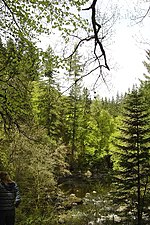Hermitage Bridge (Dunkeld, Scotland)

The Hermitage Bridge is an ancient, single-arch stone pedestrian bridge crossing the River Braan near Dunkeld, Perth and Kinross, Scotland. A Category A listed structure, it is in the bounds of The Hermitage, a National Trust for Scotland-protected site. The bridge should not be confused with the Rumbling Bridge, which carries motorised traffic, about 0.62 miles (1.00 km) to the southwest.The bridge was built by order of John Murray, 3rd Duke of Atholl, presumably to gain access across to some lands leased from Sir John Stewart of Murthly, as well as assisting with the views of the Black Linn Falls. It has since become a major landscape feature and has been the subject of several paintings and sketches, including from George Washington Wilson's visit around 1859.An arch (added around 1785) stands across the western entrance, while underneath its eastern end, the bridge contains a small arch giving access to the ledge below Ossian’s Hall and to a small grotto.
Excerpt from the Wikipedia article Hermitage Bridge (Dunkeld, Scotland) (License: CC BY-SA 3.0, Authors, Images).Hermitage Bridge (Dunkeld, Scotland)
Hermitage Bridge,
Geographical coordinates (GPS) Address External links Nearby Places Show on map
Geographical coordinates (GPS)
| Latitude | Longitude |
|---|---|
| N 56.5574352 ° | E -3.6143987 ° |
Address
Hermitage Bridge
Hermitage Bridge
PH8 0JR
Scotland, United Kingdom
Open on Google Maps











